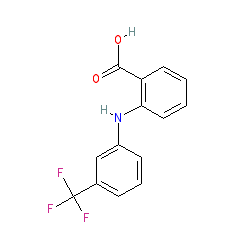|
flufenamic acid is an approved drug
Compound class:
Synthetic organic
Comment: A non-selective cyclooxygenase inhibitor; NSAID.
Ligand Activity Visualisation ChartsThese are box plot that provide a unique visualisation, summarising all the activity data for a ligand taken from ChEMBL and GtoPdb across multiple targets and species. Click on a plot to see the median, interquartile range, low and high data points. A value of zero indicates that no data are available. A separate chart is created for each target, and where possible the algorithm tries to merge ChEMBL and GtoPdb targets by matching them on name and UniProt accession, for each available species. However, please note that inconsistency in naming of targets may lead to data for the same target being reported across multiple charts. ✖ |
|
|||||||||||||||||||||||||||||||||||
| References |
|
1. Chen XZ, Vassilev PM, Basora N, Peng JB, Nomura H, Segal Y, Brown EM, Reeders ST, Hediger MA, Zhou J. (1999)
Polycystin-L is a calcium-regulated cation channel permeable to calcium ions. Nature, 401 (6751): 383-6. [PMID:10517637] |
|
2. Dai L, Garg V, Sanguinetti MC. (2010)
Activation of Slo2.1 channels by niflumic acid. J Gen Physiol, 135 (3): 275-95. [PMID:20176855] |
|
3. Di Pizio A, Waterloo LAW, Brox R, Löber S, Weikert D, Behrens M, Gmeiner P, Niv MY. (2020)
Rational design of agonists for bitter taste receptor TAS2R14: from modeling to bench and back. Cell Mol Life Sci, 77 (3): 531-542. [PMID:31236627] |
|
4. Garg P, Sanguinetti MC. (2012)
Structure-activity relationship of fenamates as Slo2.1 channel activators. Mol Pharmacol, 82 (5): 795-802. [PMID:22851714] |
|
5. Hill K, Benham CD, McNulty S, Randall AD. (2004)
Flufenamic acid is a pH-dependent antagonist of TRPM2 channels. Neuropharmacology, 47 (3): 450-60. [PMID:15275834] |
|
6. Hu H, Tian J, Zhu Y, Wang C, Xiao R, Herz JM, Wood JD, Zhu MX. (2010)
Activation of TRPA1 channels by fenamate nonsteroidal anti-inflammatory drugs. Pflugers Arch, 459 (4): 579-92. [PMID:19888597] |
|
7. Matsuura K, Shiraishi H, Hara A, Sato K, Deyashiki Y, Ninomiya M, Sakai S. (1998)
Identification of a principal mRNA species for human 3alpha-hydroxysteroid dehydrogenase isoform (AKR1C3) that exhibits high prostaglandin D2 11-ketoreductase activity. J Biochem, 124 (5): 940-6. [PMID:9792917] |
|
8. Skarydová L, Zivná L, Xiong G, Maser E, Wsól V. (2009)
AKR1C3 as a potential target for the inhibitory effect of dietary flavonoids. Chem Biol Interact, 178 (1-3): 138-44. [PMID:19007764] |
|
9. Togashi K, Inada H, Tominaga M. (2008)
Inhibition of the transient receptor potential cation channel TRPM2 by 2-aminoethoxydiphenyl borate (2-APB). Br J Pharmacol, 153 (6): 1324-30. [PMID:18204483] |
|
10. Ullrich ND, Voets T, Prenen J, Vennekens R, Talavera K, Droogmans G, Nilius B. (2005)
Comparison of functional properties of the Ca2+-activated cation channels TRPM4 and TRPM5 from mice. Cell Calcium, 37 (3): 267-78. [PMID:15670874] |









